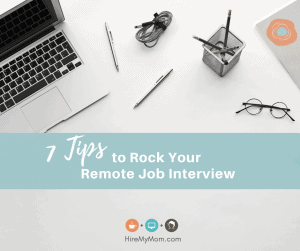Four Powerful Habits to Boost Productivity and Get More Done Each Day

As moms, we understand the power of habits. We develop habits to help our families keep moving. We encourage our children to develop good habits as they grow. The habits we depend on make it possible for us to keep many balls in the air while guiding our children to adulthood with support and direction.
When you work from home, habits can serve the same purpose in your professional life. Key productivity habits can help make your days easier.
Over the years, the HireMyMom team has observed the habits of highly productive and organized work-from-home moms. Here, we share their habits with you.
Set Goals Early and Often
In Stephen Covey’s famous and bestselling book, The 7 Habits of Highly Effective People, he advises “to begin with the end in mind.” In our experience, starting with that view when approaching your work from a home office can help move the needle on productivity. Having a clear destination helps to keep you on track. Knowing your goals enables you to make decisions that support your overall objectives.
We tend to think of goal setting as an annual affair. While it’s true that a yearly cycle can help you develop longer-term goals, one habit we often see in successful work-at-home moms is that they set goals regularly and often in multiple time increments.
For example, if you have a big project due in 30 days, finishing it could be a goal for the month. Breaking the project down into smaller weekly and daily tasks provides shorter-term goals that can make your work more productive and help guide your decisions around the actions that will help you realize your goals.
For best results, write your goals down. Research shows you are 42% more likely to achieve goals if you write them down.
Make a List
There’s nothing better than creating a to-do list and then crossing items off as you complete them. And, for moms who work at home, regularly creating a to-do list is an essential tool and an important habit.
There are many ways to make a list–you can use pen and paper, dash off an online list, or use a phone-based app. The important thing here is to take all the tasks rattling around in your brain and dump them into one place that’s easy to access and quick to read.
Here’s a low-tech approach we often see used and many find effective.
- Treat yourself to a fun or pretty notebook and designate it for keeping all your lists and notes together.
- Write your long-term goals on the inside cover and any pertinent information that you need regularly but don’t always remember on the back cover.
- Draw a line down the middle of a fresh page each day. At the top, write “work” on top of the left column and “personal” on the right side.
- Assign tasks into each category. This method differentiates personal and professional tasks, which helps you be more efficient when you sit down to work.
- Fill in the tasks that you aim to achieve that day, using your goals as a guide.
- Place the most important jobs at the top of the list or put a star next to them, so they draw your attention.
- Enjoy crossing items off as you complete them.
Establish a Routine
As a mom, you know that babies and children thrive on comfortable routines. As a work-from-home mom, a routine can help you feel a greater sense of control over your life and time. Knowing what comes next and when makes much of your day easier because you don’t have to stop and think about each step. Instead, you fall into a daily rhythm that helps you thrive.
Many work-related routines fall away when you work from home–there’s no commute, you don’t have to get dressed or pack a lunch. While that has a beautiful quality, it also eliminates powerful signals to your brain that it’s time to work.
As a work-from-home mom, create new routines to set the stage for productivity. Here are some ideas to establish a routine:
- Set specific work hours and honor them as much as you can.
- Batch your work by dividing your day into increments for doing certain things. For example, start each day by checking your email for 30 minutes. Then move on to a block of time dedicated to project-based tasks.
- Use a timer to help keep you on track. For example, if you designate 30 minutes for email, use a timer to help ensure that email responses don’t eat up a block of time set for another task. As your routine falls into place, you won’t need the timer as much because you will feel the transition times as they approach–that’s part of the power of a routine.
- Set aside break times to connect with a colleague through slack or gchat or walk around for a few minutes–just like you would in the office.
If you find Mondays particularly difficult, check out these tips to start your work week off right.
Develop Rituals
It’s tough to transition out of mom mode and right into professional mode without taking a few minutes to reset.
When you work outside the home, preparing for the day and completing your commute are rituals that help you with the transition. But, when your commute is just a few steps down the hall, you lose that time and process.
Developing a few short rituals to ease the transition can make you feel fully present as you start your workday and can help increase your productivity. Here are a few suggestions to help create rituals to begin your workday:
- Pour a cup of coffee.
- Sip it as your walk around the block.
- Listen to a short podcast related to your work.
- Check your goals as you sit down at your desk to ground yourself in the day’s tasks.
At the end of each workday, rituals can help you transition back into mom mode. When you wrap up your workday, try:
- Closing any open documents on your desktop.
- Review your to-do list and cross out any completed tasks.
- Make a few notes for the next day.
- Close your eyes for two minutes and reflect on the day. Try to leave any stress behind.
- Shut your office door, physically or metaphorically, as you leave work for the day
Share!
Tell us the habits that you depend on to maximize productivity.









